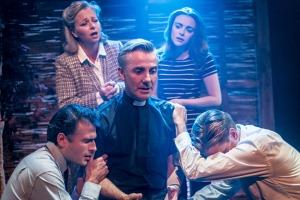See What I Wanna See
Michael John LaChiusa is one of the most intricate, innovative and ground-breaking composers of modern musical theatre whose work is not widely known in the UK, but has achieved distinction in his native New York. Whilst his Broadway version of 'The Wild Party' may be his crowing achievement, downtown productions of 'Giant' and 'Hello Again' have allowed his work to build a healthy following and earn an international reputation.
Adam Lenson's finely directed production of this 2004 off-Broadway musical brings together three separate stories with similar, although not overtly concurrent themes, culminating in a strikingly bold and thought provoking musical. Told in two parts with two prologues, each act begins with the story of medieval lovers Kesa and Morito. The first act then concerns a murder in Central Park in 1951 from the various perspectives of several different characters, with the second act following a priest who creates a hoax about a miracle in the aftermath of 9/11 as his faith begins to wane.
This is a project that has clearly been awarded careful care and attention. In his director's notes, Lenson talks about first directing the show whilst at university, and his love for the piece is clear throughout as he finely juggles the tone between each story, but doesn't force a specific idea or solitary theme, which allows the audience to then settle where they wish.
The overall effect of the narrative is best summed up by the title. Audiences will each take something different away from the production, quite literally seeing what they want to see. Discussions can be had between the connections between each of the stories, as well as the musical connections and repeated motifs, but the three stories can also be appreciated in isolation.
The cast are the tightest ensemble I've seen on the fringe for some time, with not a weak link throughout the vocally demanding score and varied character tracks. Sarah Ingram provides comedy and heart to her second act narrative, whilst Jonathan Butterell finds similarities in his two very different characters. Cassie Compton's voice matches the astonishing demands placed on her, with a real sense of danger in her prologues and first act story. Mark Elliott shines particularly in the first act as the thief whose perspective on the drama was the easiest to latch onto.
I wonder how casual musical theatre fans would feel about the score, which is one of LaChiusa's most stylistic and conversational, as it's certainly not something you go out humming. It's never showy or unnecessary, instead it's highly functional and weighted with authenticity that you quickly allow yourself to succumb to its distinct style and repetitive ostinatos that help drive both character and situation.
For such a difficult score, the vocal performances were flawless and aided by an exceptionally tight band, led by musical director Richard Bates. The synchronicity between the action and the music was outstanding, with the score providing sound effects and underscore to movement that were perfectly aligned. The balance was equally perfect, with some incredible playing from Reed player Elaine Booth in particular who managed what has to be the most difficult flute pad in a musical.
It's refreshing to see such a challenging musical presented on the fringe, in what is a clean and clear production, aided by effective set design and outstanding lighting design (James Smith) that lifted the multifunctional set and allowed your imagination to fill in the required blanks of both space and time. A rare example of one of the finest modern musical theatre composers in a challenging and vital production.
Originally published on
